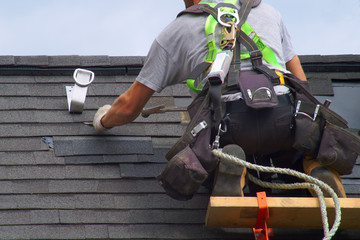Repairing a roof is an important part of home maintenance. Construction can help prevent further damage to your roof, the interior of your home, and other parts of your structure. It’s best to get the job done right away, especially if the weather is bad. Waiting until after the storm season is over could cost you more money in the long run.

Shingles are one of the most important parts of your roof. They protect your home from all kinds of weather, and they also help keep heat inside the house, so you don’t have to spend more money on energy bills. When shingles get old and dry out, they can become stiff, curl up, or crack. They may even have missing granules. These granules are what make the shingle waterproof and protect your home from the sun’s harmful rays. Missing granules can be an indication that the shingle needs to be replaced.
Another common sign of damaged shingles is water stains and streaks on your ceiling. This can be a symptom of a leak, and is often a good reason to hire a roofing contractor to fix the problem. In addition to repairing a shingle, a good roofing crew will also replace damaged valley flashing and drip edging. This will raise the total cost of your project, but it will help improve your roof’s lifespan and eliminate small issues that could turn into costly repairs in the future.
Flashing is a material used to direct rainwater and other precipitation away from your roof. It’s typically installed at roof intersections, projections and around windows and doors to help prevent leaks from occurring. The material is generally made of aluminum or a similar metal, although it can also be made of plastic or other materials. It is then rolled out onto the roof, and then sealed to prevent leaks.
In addition to valleys, where two roof slopes meet, flashing is also installed around chimneys, skylights, vents and dormers, and the rake edges of your roof. When it comes to Roof Repair, it is important to pay attention to flashing because if it is damaged or deteriorating, it can allow water to enter the home and cause damage to everything from ceiling tiles to walls. It can also rot the wood roof deck, which can lead to a buckled roof and costly repairs in the future.
Underlayment is a layer of synthetic fiber or felt installed over the roof deck and under your shingles. It acts as a waterproof barrier to prevent moisture from seeping into your home and helps insulate the roof. Depending on your specific needs and region, there are a few different types of underlayment. Traditionally, the most common type is asphalt-saturated felt, but over the years other materials have become more popular.
Felt underlayment is made from a flexible base that is saturated with asphalt to offer water resistance. It is available in both 15-pound and 30-pound thicknesses. Synthetic underlayment is a more durable option than asphalt-saturated felt. It is not sensitive to UV rays, which means it will last longer and resist deterioration better. Rubberized underlayment is another popular choice. It typically uses peel-and-stick fasteners, which make it easy to attach without damaging your roof deck. Some also self-seal around nails and staples.
The soffit and fascia are often overlooked when it comes to repairing or replacing your roof. However, they play a key role in ensuring that your home is protected against the elements and maintaining its integrity. The soffit is the part of your roof that overhangs your eaves. It helps to cover the exposed rafters and protects your roof from rainwater, rodents, and mold.
Another important function of your soffit is ventilation. Without proper ventilation, your attic can become too hot and moisture can build up, which can lead to rot and mould growth. If your soffit is damaged or has holes, you may need to replace it. The cost of soffit replacement depends on the size of your house and the material you choose.
